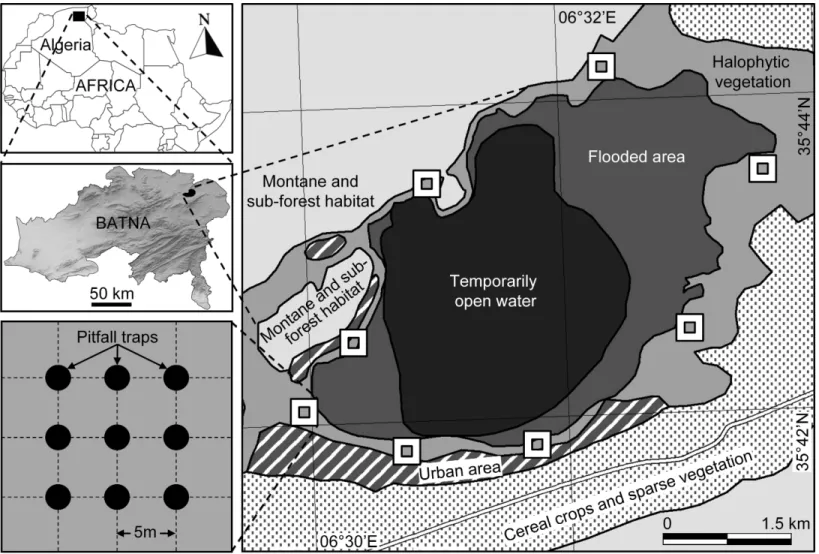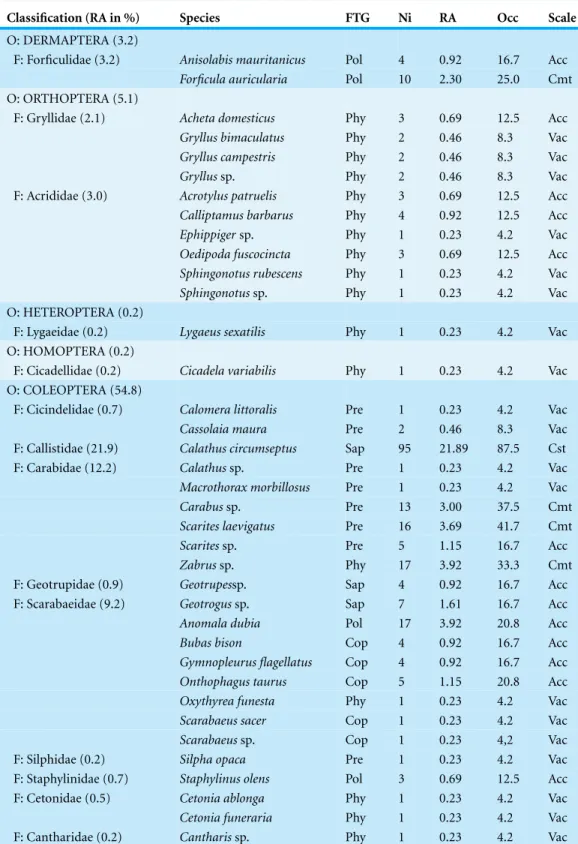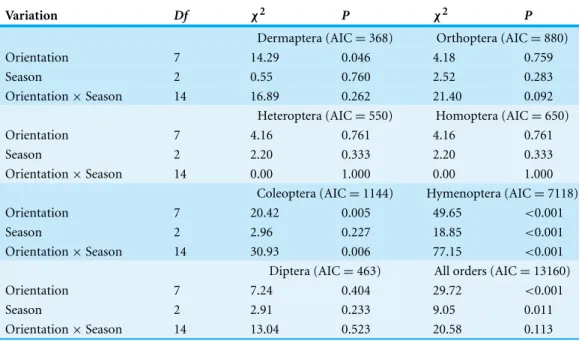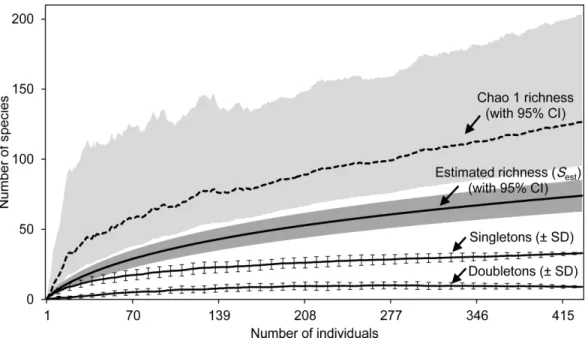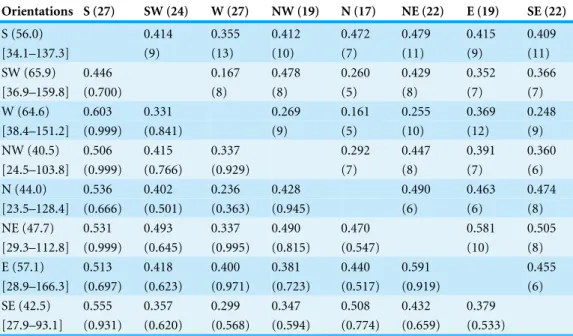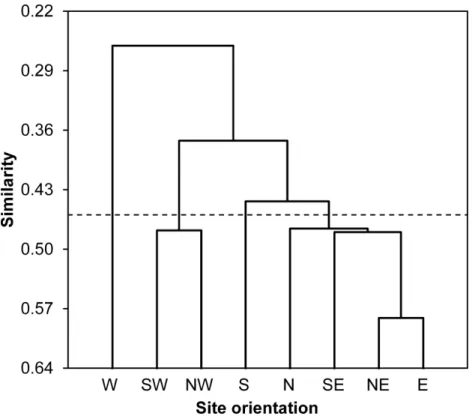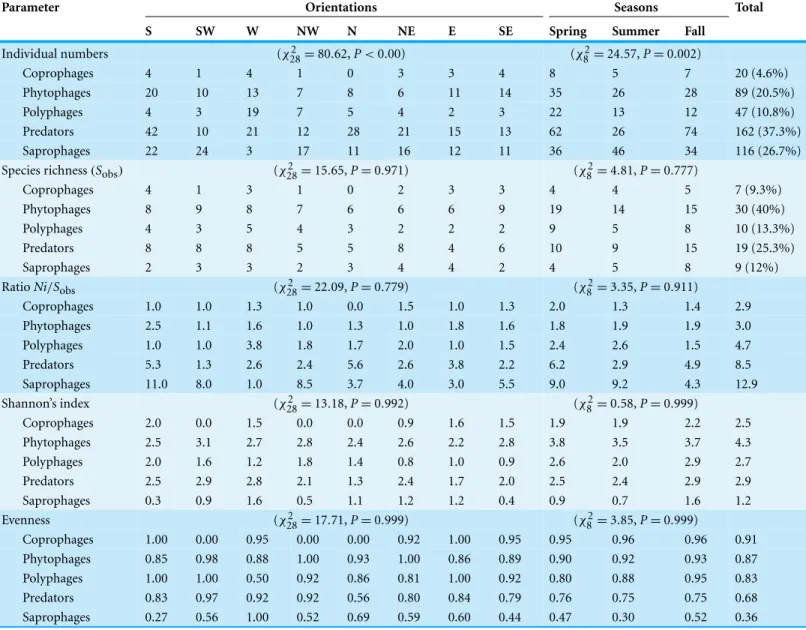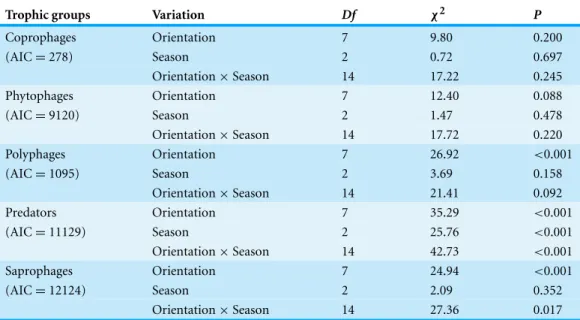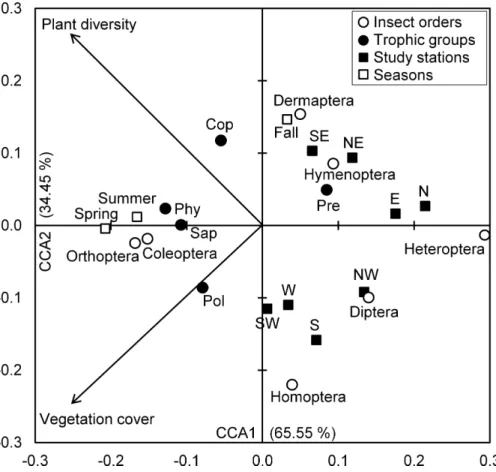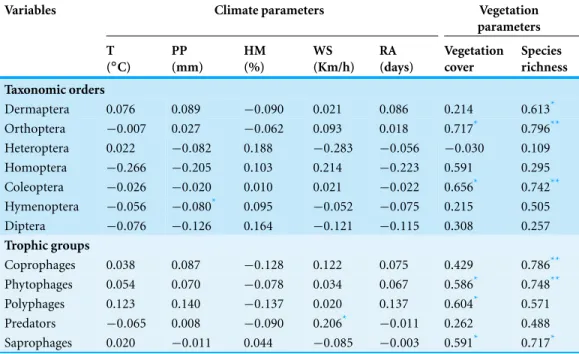Submitted20 December 2014
Accepted 6 March 2015
Published24 March 2015
Corresponding author Haroun Chenchouni, chenchouni@gmail.com
Academic editor Isabelle Larocque-Tobler
Additional Information and Declarations can be found on page 21
DOI10.7717/peerj.860
Copyright 2015 Chenchouni et al.
Distributed under
Creative Commons CC-BY 4.0
OPEN ACCESS
Spatiotemporal diversity, structure and
trophic guilds of insect assemblages in a
semi-arid Sabkha ecosystem
Haroun Chenchouni1, Taha Menasria2, Souad Neffar1, Smail Chafaa3, Ly`es Bradai4, Rachid Chaibi5, Mohamed Nacer Mekahlia1,
Djamel Bendjoudi6and Abdelkrim Si Bachir3
1Department of Natural and Life Sciences, Faculty of Exact Sciences and Natural and Life Sciences, University of Tebessa, Tebessa, Algeria
2Department of Applied Biology, Faculty of Exact Sciences and Natural and Life Sciences, University of Tebessa, Tebessa, Algeria
3Department of Natural and Life Sciences, Faculty of Sciences, University of El Hadj Lakhdar, Batna, Algeria
4Department of Biology, Faculty of Natural and Life Sciences, University of Kasdi Merbah, Ouargla, Algeria
5Department of Biology, Faculty of Sciences, University of Amar Telidji, Laghouat, Algeria 6Department of Biology of Populations and Organisms, Faculty of Agro-veterinary and Biology,
University of Saad Dahlab, Blida, Algeria
ABSTRACT
Subjects Biodiversity, Ecology, Ecosystem Science, Entomology, Zoology
Keywords Entomological biodiversity, Sabkha Djendli, Insect community ecology, Pitfall trapping, Algeria, Ecological niche, Functional groups, Conservation biology, Inland wetlands, Semi-arid lands
INTRODUCTION
Wetlands are recognized as important ecosystems in terms of biodiversity and functional role. These ecosystems include a remarkable range of habitats that are ecologically considered among the most productive ecosystems worldwide, with large socio-economic importance and high heritage values for humanity. They play crucial and major ecological functions, including trapping, absorbing and eliminating of potential toxic chemicals and pollutants, storage of natural carbon, recycling of nutrients, as well as they contribute to groundwater recharge in arid and semi-arid regions. Unfortunately, wetlands are experiencing rapid degradation due to severe transformations related to intensive human activities (Bobbink et al., 2006;Mitsch et al., 2009).
More than 2000 wetlands are listed in Algeria, including 50 sites classified on the Ramsar list of wetlands of international importance (Balla, 2012). Most of large inland saline depressions and backwaters “Sabkhas, Chotts, and Oases” are located in arid and semi-arid regions, with a unique agglomeration of this type of sites in northeastern of the country (Chenchouni & Si Bachir, 2010). The most characteristic type of the Algerian wetlands is seasonal/intermittent endorheic type that consists of Sabkha ecosystems “saline lakes” with typical alternation of drought phase in summer and flooding in winter (Khaznadar, Vogiatzakis & Griffiths, 2009;Balla, 2012).
Large-scale conservation programs focused on wetlands because these habitats support both terrestrial and aquatic biota where biodiversity therein is remarkably high (De Roeck et al., 2007). This biodiversity is the key factor maintaining the structure, stability, and functioning of these ecosystems (Ivask et al., 2008). What makes its conservation at different organizational levels (individual, population, community, ecosystem) has become an issue that deserves national and international attention (Bobbink et al., 2006;
Montagna et al., 2012). Moreover, regional contributions have also proven their impact in improving the knowledge and conservation of these habitats (Pi˜nero et al., 2011;Chaibi et al., 2012;Guezoul et al., 2013).
As a biological model, invertebrates embrace a large species richness ranging over several taxa with large magnitude of sizes. They colonise various microhabitats and perform an extraordinary diverse functional roles, constituting thus key organisms at different trophic levels inside food webs of wetland ecosystems (Koricheva et al., 2000;
Furthermore, it is well known that biodiversity and structure of invertebrates, particularly insects, in saline inland temporary wetlands are governed by two main abiotic factors: hydroperiod “water regimes” and salinity (Bilton, Freeland & Okamura, 2001;
Brock, Nielsen & Crossle, 2005;Gascon et al., 2005;Waterkeyn et al., 2008), whereas the involved biotic factors are dealing with vegetation traits and various biotic interactions of food webs (Koricheva et al., 2000;Carver et al., 2009;Haddad et al., 2009). However, although species diversity is a good parameter for valuing structure of invertebrate communities and defining conservation strategies, scarcity of species should also be taken into account (Nijboer & Verdonschot, 2004).
The multi-scale ecological surveys that investigated animal biodiversity of the Algerian wetlands, specifically at the northeast of the country, they focused on waterbirds (e.g.,
Samraoui & Samraoui, 2008), fishes (e.g.,Chaibi et al., 2012), and some other taxa like dragonflies (e.g.,Samraoui et al., 2011), whereas the ecology of terrestrial arthropods of Sabkha ecosystems remain very little studied in these saline environments (Hogarth & Tigar, 2002).
Located in high plains of Northeast Algeria, the Sabkha Djendli is a seasonal salt lake whose flora was thoroughly surveyed throughout the waterbody vicinity (Neffar, Chenchouni & Si Bachir, in press). However, there had been very little investigation of faunal communities, including insects, inhabiting the Sabkha and its environs in connection with their biotope, except for some ornithological surveys of wintering waterbirds (e.g.,Samraoui & Samraoui, 2008;Bensizerara et al., 2013).
The study of relationships between spatiotemporal variation of invertebrate com-munities and ecological parameters provides valuable information for conservation assessment and restoration planning, and may efficiently guide the implementation of future management program (Comin & Comin, 1992;Fischer & Lindenmayer, 2007;
Montagna et al., 2012). Furthermore, the assessment of functional trophic groups is crucial to outlining the structure of food webs and, accordingly, identifying any perturbation in the ecosystem functioning (Chesson & Huntly, 1997;Gascon et al., 2005), particularly under changing environmental conditions. Indeed, some insect groups such as dragonflies, hoverflies and some ground beetles (particularly Carabidae) represent good indicators of biodiversity assessment and monitoring in wetlands and mesic environments (Rainio & Niemel¨a, 2003;S´anchez-Fern´andez et al., 2006;Hepp & Melo, 2013). In fact, the core aim of the current study is placed within the perspective of insect biodiversity assessment for conservation purpose as outlined here above.
insect orders and functional trophic groups; and (v) determine how climate and vegetation parameters influence spatial and seasonal fluctuations of insect assemblages.
MATERIALS AND METHODS
Study areaSabkha Djendli (35◦42′56′′N, 6◦31′46′′E) belongs to the eco-complex of wetlands located in the High Plains “Hauts Plateaux” region in eastern Algeria (Fig. 1). The site is a temporary lake with brackish/salt water that highly depends on rainfall amounts and water regime. Sabkha Djendli covers about 3,700 ha with an average altitude of 833 m in an area where inhabitants are mainly involved in agricultural activities like cereal and fruit cultivation and livestock of sheep and cattle. The adjacent land use types of this area includes scattered and low intensity urban use within extended rainfed cereal crops of barley, durum and bread wheat. The nearby mountains are covered by open shrub-forest vegetation, where the main tree species areJuniperus phoenicea,Quercus ilexandOlea oleaster(Bensizerara et al., 2013).
Based on meteorological data provided by the meteorological station of Batna (WMO Id: 60468) of the period 1974–2014, the climate of the study area is typically semi-arid Mediterranean, characterised by cold-wet winters and hot-dry summers. The dry period extends over four months from June to September. Precipitation is erratic and there are large temporal variations. The coldest month is January with an average temperature of 5.3◦C, and the hottest month is July with an average temperature of 25◦C. The relative
humidity of the air fluctuates between 40% and 75% and the winds are generally low in dominance west to south-west, with the passage of Sirocco in summer during July–August.
The natural vegetation is represented by halophytes such asAtriplex halimus,Suaeda fructicosa,Suaeda vermiculata, andSarcocornia fructicosa, but also other spontaneous vegetation likeTamarix gallica,Artemisia herba-albaandJuncus maritimus(Neffar, Chenchouni & Si Bachir, in press). The current entomological survey was carried on the belt of halophytic vegetation surrounding the Sabkha (Fig. 1).
Sampling design
Figure 1 Location and sampling design.Location of the sampled station and sites at Sabkha Djendli (Batna, Northeast Algeria) and sampling design of pitfall traps.
Data mining
Species richness estimation
Biodiversity of insects was assessed by species richness observed “Sobs,” which corresponds
to the total number of identified insect species at each station or season. In addition, Shannon’s index (H′ = −pi×log2pi) and evenness (Evenness=H′/log2Sobs) were
applied for measuring insect diversity in each sampled station and season period based on the relative densitypiof theith species (Magurran, 2004).
Estimated species richness was calculated with the program EstimateS 9.1.0 (Colwell, 2013).Sestwas extrapolated by the selection of the least biased and most precise estimator
(Brose & Martinez, 2004). We applied the following nonparametric species richness estimators: (i)Sest(analytical) with lower and upper bounds of 95% Confidence Interval
‘CI,’ which gives the expected number of species represented among a given number of individuals (Colwell et al., 2012), (ii) Chao 1 richness estimator with log-linear 95% confidence interval lower and upper bounds (Chao, 1984). These two estimators were selected because of the involved assumptions about the underlying species abundance distribution remain fewer. However, instead of using the bias-corrected form of the Chao-1 estimator, we chose the larger of Chao-1 Classic and ACE ‘Abundance-base Coverage Estimator’ because the coefficient of variation (CV) of the abundance in our dataset was high (i.e., CV>0.5). Number of singletons (species with only one individual among total individuals) and doubletons (species with only two individuals among total individuals) were given as mean (±standard deviation ‘SD’) among 100 runs of randomizations. Detailed descriptions of these estimators and procedures can be found inColwell (2013). In order to assess the diversity of the entomofauna of Sabkha Djendli as a whole, interpolated species accumulation curves “individual-based rarefaction” (Magurran, 2004;Colwell et al., 2012) of the total data were computed with both previous estimators (Sestand Chao-1 with
95% CI). Model of total raw data is multiple individual-based abundance samples (batch input, including stations and seasons:Table S2) applied for species richness estimation using EstimateS 9 (Colwell, 2013). Rarefaction curves were made by repeatedly sampling the collected species with 100 randomisations of individual orders without replacement. With the plot of individual-based rarefaction curves, we incorporated the means of singletons and doubletons (±SD) in order to allow comparison of species richness.
Statistical analyses
Agglomerative hierarchical clustering (AHC) was applied to cluster sampled stations according to their species abundances based on the proximity matrix including values of Bray-Curtis index. The agglomeration method we used was the unweighting pair-group average.
Moreover, Pearson’s Chi-squared test (χ2) was applied to look for dependencies between the distributions of structural traits values (Ni,Sobs,Ni/Sobs,H′, Evenness) of
the functional trophic groups among both study stations and seasons.
Generalized linear models (GLMs) were applied to test spatiotemporal variations of abundances of both taxonomic orders and trophic groups following the effects of ‘Orientation,’ ‘Season’ and their interaction ‘Orientation×Season.’ As all abundances were count data, GLMs were fitted using a Poisson distribution error and log link function (Myers et al., 2012). Computations were carried out with the help of R (R Core Team, 2015) using the ‘glm’ function and ‘AIC’ function to calculate the Akaike’s information criterion (AIC) as model simplification. Likelihood-ratio tests “LR” were performed for each GLM to assess the effects of explicative factors (Orientation, Season and Orientation×Season). Each “LR” was tested using sequential “Type-I” under the ‘Anova’ function that computes the deviance (χ2) and the correspondingP-value (Fox, 2008).
The spatiotemporal gradients of insect assemblages were analyzed in relation with vegetation traits using a canonical correspondence analysis (CCA). The data used were the abundances of both taxonomic orders and trophic groups on the study seasons and orientations where they were counted. For the spontaneous vegetation, two parameters were assessed at each orientation and season: the vegetation cover (%) and total species richness (number of plant species). These data were generated fromNeffar, Chenchouni & Si Bachir (in press). Since the CCA has the ability to combine ordination and gradient analysis functions in a readily interpretable manner, it was applied to relate spatiotemporal insect abundances to vegetation variables in order to highlight relationships between spatiotemporal variations of insects and vegetation traits as explanatory variables (Jongman, Ter Braak & Tongeren, 1995). At the end of overcoming the disadvantage effect of scale differences in data, insect densities as well as vegetation variables were normalized using normal distribution transformation based on the average and standard deviation of each input.
(Chafaa et al., 2013;Idder-Ighili et al., in press). All correlations were carried out as pairwise two-sided tests using the function ‘rcorr.adjust’ in R (R Core Team, 2015).
RESULTS
Taxonomic composition of insect community
Pitfall sampling of entomofauna at Sabkha Djendli revealed an insect community composed of 75 species from 434 individuals caught. This entomofauna can be classified into 7 orders, 31 families and 62 genera (Table 1). Coleoptera was the best represented with 238 (54.8%) individuals caught belonging to 39 species and 15 families, followed by Hymenoptera with 149 (34.3%) individuals of 18 species and 8 families, then came Orthoptera with 22 individuals (10 species and 2 families). The orders Dermaptera, Heteroptera, Homoptera and Diptera were poorly represented by either species or catch abundance. Furthermore, the identified entomofauna included five functional trophic groups: phytophages with 30 species, predators with 19 species, polyphages with 10 insects, saprophages with 9 species and coprophages with 7 species.
Relative abundance and occurrence
The main species with high relative abundance (RA) of catch wereCalathus circumseptus
(21.9%),Cataglyphis biskrense(15.4%),Tetramorium biskrensis(6%),Zabrussp. (3.9%),
Anomala dubia(3.9%),Scarites laevigatus(3.7%) andCarabussp. (3%), respectively. Furthermore, families that dominated in terms of catches belonged to Coleoptera and Hymenoptera, including Formicidae with a total of 111 individuals (25.6%), Callistidae with 95 individuals (21.9%), Carabidae with 53 individuals (12.2%) and Scarabeidae with 40 individuals (9.2%), and Apidae with 29 individuals the equivalent of 6.0% of total caches (Table 1).
Regarding spatial occurrence of insect species at the eight sampled stations, almost all species (66 species) were accidental and very accidental. Nevertheless, three species were constant (Occ≥50%) during the study period:Chlaenius circumseptus(Callistidae),
Cataglyphis bicolor(Formicidae) andTetramorium biskrensis(Formicidae). Common species (Occ=25–50%) were characterized by six species:Scoliasp. (Scoliidae),Apis mellifera(Apidae)Zabrussp. (Carabidae)Carabussp. (Carabidae)Scarites laevigatus
(Carabidae)Forficula auricularia(Forficulidae) (Table 1).
Spatiotemporal composition and diversity
The sampled station located southern Sabkha Djendli possessed the highest values of catch seize (93 individuals,RA=21.4%), species richness (27 species) and the ratio Ni/Sobs(3.4), whereas the highest values of Shannon index and evenness were respectively
recorded at station of West, Southeast, South, and East. However, this later station (East) had the lowest values of insect composition (Ni=43,RA=9.9%,Sobs=19).
Table 1 Insect listing.Systematic list, trophic status, abundances and occurrences of insect species captured using pitfall traps at edges of Sabkha Djendli, Northeast Algeria.
Classification (RA in %) Species FTG Ni RA Occ Scale
O: DERMAPTERA (3.2)
F: Forficulidae (3.2) Anisolabis mauritanicus Pol 4 0.92 16.7 Acc
Forficula auricularia Pol 10 2.30 25.0 Cmt
O: ORTHOPTERA (5.1)
F: Gryllidae (2.1) Acheta domesticus Phy 3 0.69 12.5 Acc
Gryllus bimaculatus Phy 2 0.46 8.3 Vac
Gryllus campestris Phy 2 0.46 8.3 Vac
Gryllussp. Phy 2 0.46 8.3 Vac
F: Acrididae (3.0) Acrotylus patruelis Phy 3 0.69 12.5 Acc
Calliptamus barbarus Phy 4 0.92 12.5 Acc
Ephippigersp. Phy 1 0.23 4.2 Vac
Oedipoda fuscocincta Phy 3 0.69 12.5 Acc
Sphingonotus rubescens Phy 1 0.23 4.2 Vac
Sphingonotussp. Phy 1 0.23 4.2 Vac
O: HETEROPTERA (0.2)
F: Lygaeidae (0.2) Lygaeus sexatilis Phy 1 0.23 4.2 Vac
O: HOMOPTERA (0.2)
F: Cicadellidae (0.2) Cicadela variabilis Phy 1 0.23 4.2 Vac O: COLEOPTERA (54.8)
F: Cicindelidae (0.7) Calomera littoralis Pre 1 0.23 4.2 Vac
Cassolaia maura Pre 2 0.46 8.3 Vac
F: Callistidae (21.9) Calathus circumseptus Sap 95 21.89 87.5 Cst
F: Carabidae (12.2) Calathussp. Pre 1 0.23 4.2 Vac
Macrothorax morbillosus Pre 1 0.23 4.2 Vac
Carabussp. Pre 13 3.00 37.5 Cmt
Scarites laevigatus Pre 16 3.69 41.7 Cmt
Scaritessp. Pre 5 1.15 16.7 Acc
Zabrussp. Phy 17 3.92 33.3 Cmt
F: Geotrupidae (0.9) Geotrupessp. Sap 4 0.92 16.7 Acc
F: Scarabaeidae (9.2) Geotrogussp. Sap 7 1.61 16.7 Acc
Anomala dubia Pol 17 3.92 20.8 Acc
Bubas bison Cop 4 0.92 16.7 Acc
Gymnopleurus flagellatus Cop 4 0.92 16.7 Acc
Onthophagus taurus Cop 5 1.15 20.8 Acc
Oxythyrea funesta Phy 1 0.23 4.2 Vac
Scarabaeus sacer Cop 1 0.23 4.2 Vac
Scarabaeussp. Cop 1 0.23 4,2 Vac
F: Silphidae (0.2) Silpha opaca Pre 1 0.23 4.2 Vac
F: Staphylinidae (0.7) Staphylinus olens Pol 3 0.69 12.5 Acc
F: Cetonidae (0.5) Cetonia ablonga Phy 1 0.23 4.2 Vac
Cetonia funeraria Phy 1 0.23 4.2 Vac
F: Cantharidae (0.2) Cantharissp. Phy 1 0.23 4.2 Vac
Table 1 (continued)
Classification (RA in %) Species FTG Ni RA Occ Scale
F: Meloidae (1.4) Mylabris crocata Phy 1 0.23 4.2 Vac
Mylabris quadripunctata Phy 2 0.46 8.3 Vac
Mylabris variabilis Phy 3 0.69 12.5 Acc
F: Tenebrionidae (2.3) Adesmia microcephala Sap 1 0.23 4.2 Vac
Blaps mortisaga Sap 1 0.23 4.2 Vac
Blaps nitens Sap 1 0.23 4.2 Vac
Opatrumsp. Sap 2 0.46 8.3 Vac
Tentyria bipunctata Sap 1 0.23 4.2 Vac
Tentyriasp. Sap 4 0.92 12.5 Acc
F: Dermestidae (1.2) Dermestessp. Cop 1 0.23 4.2 Vac
Trogodermasp. Cop 4 0.92 16.7 Acc
F: Cucujidae (0.7) Canthartussp. Pol 3 0.69 8.3 Vac
F: Curculionidae (0.5) Coniocleonus excoriatus Phy 1 0.23 4.2 Vac
Lixus punctiventris Phy 1 0.23 4.2 Vac
F: Chrysomelidae (2.3) Chrysomelasp. Phy 9 2.07 16.7 Acc
Entomoscelissp. Phy 1 0.23 4.2 Vac
O: HYMENOPTERA (34.3)
F: Formicidae (25.6) Camponotussp. Pre 1 0.23 4.2 Vac
Cataglyphis bicolor Pre 67 15.44 58.3 Cst
Messor barbarous Pre 7 1.61 12.5 Acc
Pheidole pallidula Pol 1 0.23 4.2 Vac
Tapinoma nigerrimum Pre 9 2.07 20.8 Acc
Tetramorium biskrense Pre 26 5.99 50.0 Cst
F: Vespidae (0.2) Polistes gallicus Pre 1 0.23 4.2 Vac
F: Apidae (4.9) Apis mellifera Phy 10 2.30 29.2 Cmt
Apissp. Phy 5 1.15 16.7 Acc
Bombus pascuorum Phy 2 0.46 4.2 Vac
F:Megachilidae (1.2) Megachilesp. Phy 5 1.15 16.7 Acc
F:Halictidae (0.9) Sphecodessp. Phy 1 0.23 4.2 Vac
Halictussp. Phy 3 0.69 12.5 Acc
F: Scoliidae (1.6) Scoliasp. Pre 7 1.61 25.0 Cmt
F: Sphecidae (0.7) Ammophila hirsute Pre 1 0.23 4.2 Vac
Ammophila sabulosa Pre 1 0.23 4.2 Vac
Sphex funerarius Pre 1 0.23 4.2 Vac
F: Mutillidae (0.2) Mutillasp. Pre 1 0.23 4.2 Vac
O: DIPTERA (2.1)
F: Tabanidae (0.5) Tabanussp. Pol 2 0.46 8.3 Vac
F: Muscidae (0.7) Musca domestica Pol 1 0.23 4.2 Vac
Muscasp. Pol 2 0.46 8.3 Vac
F: Sarcophagidae (0.9) Sarcophagasp. Pol 4 0.92 16.7 Acc
Notes.
Table 2 Spatiotemporal diversity.Spatial and seasonal variation of the diversity parameters of insect assemblages in Sabkha Djendli, Northeast Algeria.
Parameters Orientation Season Total
S SW W NW N NE E SE Spring Summer Fall
Abundances (Ni) 93 48 60 44 52 50 43 45 163 116 155 434
RA(%) 21.4 11.0 13.8 10.1 11.8 11.5 9.9 10.3 37.5 26.7 35.6 100
Species richness(Sobs) 27 24 27 19 17 22 19 22 46 38 51 75
RatioNi/Sobs 3.4 2.0 2.2 2.3 3.1 2.3 2.3 2.0 3.5 3.1 3.0 5.8
Shannon index (H′) 3.9 3.6 4.1 3.5 3.1 3.8 3.7 3.9 4.5 4.0 4.6 4.7
Evenness 0.81 0.79 0.86 0.83 0.77 0.84 0.86 0.87 0.82 0.76 0.82 0.76
Table 3 Abundances of insect orders.GLMs testing the effects of ‘Station orientation,’ ‘Season’ and their interaction on the variation of insect orders abundances in Sabkha Djendli, Northeast Algeria.
Variation Df χ2 P χ2 P
Dermaptera (AIC=368) Orthoptera (AIC=880)
Orientation 7 14.29 0.046 4.18 0.759
Season 2 0.55 0.760 2.52 0.283
Orientation×Season 14 16.89 0.262 21.40 0.092
Heteroptera (AIC=550) Homoptera (AIC=650)
Orientation 7 4.16 0.761 4.16 0.761
Season 2 2.20 0.333 2.20 0.333
Orientation×Season 14 0.00 1.000 0.00 1.000
Coleoptera (AIC=1144) Hymenoptera (AIC=7118)
Orientation 7 20.42 0.005 49.65 <0.001
Season 2 2.96 0.227 18.85 <0.001
Orientation×Season 14 30.93 0.006 77.15 <0.001
Diptera (AIC=463) All orders (AIC=13160)
Orientation 7 7.24 0.404 29.72 <0.001
Season 2 2.91 0.233 9.05 0.011
Orientation×Season 14 13.04 0.523 20.58 0.113
Figure 2 Estimated species richness.Species richness estimates (with 95% confidence intervals) for the estimatorsSest(analytical) and Chao 1 Classic (dashed line) based on 100 randomized samples (Colwell,
2013) for the total data of entomofauna sampled in Sabkha Djendli, Northeast Algeria. Rarefaction curves were represented by means of singletons and doubletons (±standard deviations, only every 8th data point is shown).
Estimates of species richness
For the whole Sabkha Djendli, the rarefaction curves kept increasing with the increase of number of individuals (Fig. 2). Expected species richness curves computed using the first-order Chao richness estimator proved to highly increase with the number of individuals captured all over the Sabkha. This estimator indicated that at a total of 434 individuals, Sabkha Djendli had 128 species (lower 95% CI: 96 species, upper 95% CI: 204 species). Chao-1 estimated species richness was significantly greater than the analytical estimated richness that indicated 75 species (upper 95% CI: 86 species). The individual-based rarefaction curve of singletons was higher than that of doubletons but both kept increasing to reach a plateau in all stations considered, suggesting that the expected species richness estimated with both previous estimators (Sestand Chao-1)
increased with the increase of singletons rather than doubletons. At a total of 433 individuals, the mean of singletons was 32.97±0.39 species, whereas doubletons provided
an estimate of 9±0.35 species (seeTable S5for all diversity statistics including other species richness estimators and species diversity indices computed for the total captures of insects at Sabkha Djendli).
Spatial similarities of the entomofauna
Table 4 Spatial abundance-based similarities.Similarity matrix of observed (above the diagonal) and estimated (under the diagonal) insect assemblages in the studied sites at Sabkha Djendli, Northeast Algeria. Values of observed data (above the diagonal) are referred to Bray-Curtis index (and number of shared Species). The values of raw Chao’s abundance-based Jaccard index and the estimators of their true values (Chao et al., 2005), in brackets, are given under the diagonal. Station locations ‘orientations’ of the first row are associated with values of observed species richness (Sobs), whereas orientations in
the first column are followed by means of Chao-1 richness estimator and 95% CI indicated in square brackets.
Orientations S (27) SW (24) W (27) NW (19) N (17) NE (22) E (19) SE (22)
S (56.0) 0.414 0.355 0.412 0.472 0.479 0.415 0.409
[34.1–137.3] (9) (13) (10) (7) (11) (9) (11)
SW (65.9) 0.446 0.167 0.478 0.260 0.429 0.352 0.366
[36.9–159.8] (0.700) (8) (8) (5) (8) (7) (7)
W (64.6) 0.603 0.331 0.269 0.161 0.255 0.369 0.248
[38.4–151.2] (0.999) (0.841) (9) (5) (10) (12) (9)
NW (40.5) 0.506 0.415 0.337 0.292 0.447 0.391 0.360
[24.5–103.8] (0.999) (0.766) (0.929) (7) (8) (7) (6)
N (44.0) 0.536 0.402 0.236 0.428 0.490 0.463 0.474
[23.5–128.4] (0.666) (0.501) (0.363) (0.945) (6) (6) (8)
NE (47.7) 0.531 0.493 0.337 0.490 0.470 0.581 0.505
[29.3–112.8] (0.999) (0.645) (0.995) (0.815) (0.547) (10) (8)
E (57.1) 0.513 0.418 0.400 0.381 0.440 0.591 0.455
[28.9–166.3] (0.697) (0.623) (0.971) (0.723) (0.517) (0.919) (6)
SE (42.5) 0.555 0.357 0.299 0.347 0.508 0.432 0.379
[27.9–93.1] (0.931) (0.620) (0.568) (0.594) (0.774) (0.659) (0.533)
North and East stations (Table 4). Most of the similarities did not exceed 0.500, except for the NE station with East (Bray-Curtis=0.581) and SE (Bray-Curtis=0.505) stations.
The raw Chao’s abundance-based Jaccard index indicated similarities between rest of the stations ranged from 0.236 to 0.603. The high values of that index (>0.5) were recorded between south station and all the rest of the stations except SW. As for the estimated Chao’s abundance-based Jaccard index, all estimated similarities between stations were higher than 0.500 excluding the similarity between NW and West stations where it was 0.363. The program EstimateS provided other shared species statistics (Table S6).
According to values of Bray-Curtis’s index, the eight sampled stations were clustered using AHC into four different groups: (i) the first group gathered all stations located at North and East of the Sabkha including N, NE, E and SE stations, (ii) the South station was distinguished alone, (iii) the third cluster included SW and NW stations, and (iv) the fourth group was represented by West station (Fig. 3).
Structure and diversity of functional trophic groups
Figure 3 Spatial similarity clustering.Dendrogram of the agglomerative hierarchical clustering (AHC) illustrating species abundance similarity (Bray-Curtis index) among insects captured from eight stations around Sabkha Djendli (linkage rule: unweighting pair-group average).
In terms of numbers of species, phytophages were the most abundant, with 30 species distributed almost equally along seasons and sampled stations. As forNi/Sobs ratio, it
varied between 1 and 11 with an average of 3.2 in study stations and seasons, i.e., that each species of a given trophic group comprises an average of 3.2 individuals. This ratio is higher in saprophages with 12.9, chiefly in stations of south (11), northwest (8.5), southwest (8), during the summer (9.2) and spring (9). Predators came in second place with 8.5 individuals per species.
The Shannon’s index showed high diversity among phytophages (H′=4.3) in both
seasons and sampled stations. The values of this index were lower among predators and less important in polyphages. Regarding saprophages, their diversity values were the lowest. Similarly, evenness in coprophages (0.91), phytophages (0.87) and polyphages (0.83) showed higher values compared to values of predators (0.68) and saprophages (0.36). It is noteworthy that apart from evenness, the coprophages indicated the lowest values of ecological indices calculated for different trophic groups of insects.
The Chi-square test revealed a significant dependence for the distribution of the number of individuals of trophic groups along the orientations (χ2 =80.62,P<0.001) and seasons (χ2=24.57,P=0.002) (Table 5). However, no significant dependence was observed for the rest of the features (Species richness,Ni/Sobsratio, Shannon index,
Table 5 Spatiotemporal structure and diversity of trophic groups.Spatial and seasonal variations of insect trophic guilds living in Sabkha Djendli, Northeast Algeria.
Parameter Orientations Seasons Total
S SW W NW N NE E SE Spring Summer Fall
Individual numbers (χ282 =80.62,P<0.00) (χ82=24.57,P=0.002)
Coprophages 4 1 4 1 0 3 3 4 8 5 7 20 (4.6%)
Phytophages 20 10 13 7 8 6 11 14 35 26 28 89 (20.5%)
Polyphages 4 3 19 7 5 4 2 3 22 13 12 47 (10.8%)
Predators 42 10 21 12 28 21 15 13 62 26 74 162 (37.3%)
Saprophages 22 24 3 17 11 16 12 11 36 46 34 116 (26.7%)
Species richness(Sobs) (χ282 =15.65,P=0.971) (χ82=4.81,P=0.777)
Coprophages 4 1 3 1 0 2 3 3 4 4 5 7 (9.3%)
Phytophages 8 9 8 7 6 6 6 9 19 14 15 30 (40%)
Polyphages 4 3 5 4 3 2 2 2 9 5 8 10 (13.3%)
Predators 8 8 8 5 5 8 4 6 10 9 15 19 (25.3%)
Saprophages 2 3 3 2 3 4 4 2 4 5 8 9 (12%)
RatioNi/Sobs (χ282 =22.09,P=0.779) (χ82=3.35,P=0.911)
Coprophages 1.0 1.0 1.3 1.0 0.0 1.5 1.0 1.3 2.0 1.3 1.4 2.9
Phytophages 2.5 1.1 1.6 1.0 1.3 1.0 1.8 1.6 1.8 1.9 1.9 3.0
Polyphages 1.0 1.0 3.8 1.8 1.7 2.0 1.0 1.5 2.4 2.6 1.5 4.7
Predators 5.3 1.3 2.6 2.4 5.6 2.6 3.8 2.2 6.2 2.9 4.9 8.5
Saprophages 11.0 8.0 1.0 8.5 3.7 4.0 3.0 5.5 9.0 9.2 4.3 12.9
Shannon’s index (χ282 =13.18,P=0.992) (χ82=0.58,P=0.999)
Coprophages 2.0 0.0 1.5 0.0 0.0 0.9 1.6 1.5 1.9 1.9 2.2 2.5
Phytophages 2.5 3.1 2.7 2.8 2.4 2.6 2.2 2.8 3.8 3.5 3.7 4.3
Polyphages 2.0 1.6 1.2 1.8 1.4 0.8 1.0 0.9 2.6 2.0 2.9 2.7
Predators 2.5 2.9 2.8 2.1 1.3 2.4 1.7 2.0 2.5 2.4 2.9 2.9
Saprophages 0.3 0.9 1.6 0.5 1.1 1.2 1.2 0.4 0.9 0.7 1.6 1.2
Evenness (χ282 =17.71,P=0.999) (χ82=3.85,P=0.999)
Coprophages 1.00 0.00 0.95 0.00 0.00 0.92 1.00 0.95 0.95 0.96 0.96 0.91
Phytophages 0.85 0.98 0.88 1.00 0.93 1.00 0.86 0.89 0.90 0.92 0.93 0.87
Polyphages 1.00 1.00 0.50 0.92 0.86 0.81 1.00 0.92 0.80 0.88 0.95 0.83
Predators 0.83 0.97 0.92 0.92 0.56 0.80 0.84 0.79 0.76 0.75 0.75 0.68
Saprophages 0.27 0.56 1.00 0.52 0.69 0.59 0.60 0.44 0.47 0.30 0.52 0.36
Table 6 Generalized linear models.GLMs testing the variation of abundance of insect trophic guilds between seasons and station orientations in Sabkha Djendli, Northeast Algeria.
Trophic groups Variation Df χ2 P
Coprophages Orientation 7 9.80 0.200
(AIC=278) Season 2 0.72 0.697
Orientation×Season 14 17.22 0.245
Phytophages Orientation 7 12.40 0.088
(AIC=9120) Season 2 1.47 0.478
Orientation×Season 14 17.72 0.220
Polyphages Orientation 7 26.92 <0.001
(AIC=1095) Season 2 3.69 0.158
Orientation×Season 14 21.41 0.092
Predators Orientation 7 35.29 <0.001
(AIC=11129) Season 2 25.76 <0.001
Orientation×Season 14 42.73 <0.001
Saprophages Orientation 7 24.94 <0.001
(AIC=12124) Season 2 2.09 0.352
Orientation×Season 14 27.36 0.017
Relationship between insect communities and vegetation
The Eigenvalues of CCA applied for insect assemblages and vegetation parameters in canonical axis 1 and 2 were high and explained 65.55% and 34.45% of constrained inertia, respectively. According to CCA, the density of polyphages was positively associated with vegetation cover, but this parameter had a negative influence on the number of individuals of predators, Hymenoptera and Dermaptera, especially in autumn at northeast, southeast, north and east stations. In addition, coprophage abundance was positively related with species richness of plants; however, Diptera and Homoptera were located on the negative side of the axis representing species richness of plants, and this in northwest, west, southwest and west stations. The phytophages and saprophages as well as Coleoptera and Orthoptera were also positively correlated with both axes of vegetation parameters, particularly in spring and summer seasons. Conversely, the two parameters of vegetation negatively influenced Heteroptera densities in north and east stations (Fig. 4).
Figure 4 Insects-vegetation relationships.Diagram of the canonical correspondence analysis (CCA) relating spatial and seasonal densities of insect assemblages of both taxonomic orders and trophic groups with vegetation cover and species richness. (Cop, coprophages; Phy, phytophages; Pol, polyphages; Pre, predators; Sap, saprophages).
(r=0.206,P<0.05). The rest of climates parameters were not significantly linked to taxonomic orders and trophic groups (Table 7).
DISCUSSION AND CONCLUSION
Salt lakes offer exceptional conditions for ecological studies of aquatic ecosystems, due to the frequency and intensity of changes in the biological communities compared to freshwater ecosystems (Comin & Comin, 1992). This feature is most notable in arid regions, so that these habitats are home to many original and well-adapted life forms (Chenchouni, 2012a).
Table 7 Insects-ecosystem correlations. Pearson correlation tests between abundance of orders and trophic guilds of insects and climate parameters (T, average of mean temperatures; PP, total of precipita-tion; HM, average of mean humidity; WS, mean wind speed; RA, number of rain days) and spontaneous vegetation characteristics (cover and species richness) of Sabkha Djendli, Northeast Algeria.
Variables Climate parameters Vegetation
parameters
T (◦C)
PP (mm)
HM (%)
WS (Km/h)
RA (days)
Vegetation cover
Species richness
Taxonomic orders
Dermaptera 0.076 0.089 −0.090 0.021 0.086 0.214 0.613*
Orthoptera −0.007 0.027 −0.062 0.093 0.018 0.717* 0.796** Heteroptera 0.022 −0.082 0.188 −0.283 −0.056 −0.030 0.109 Homoptera −0.266 −0.205 0.103 0.214 −0.223 0.591 0.295 Coleoptera −0.026 −0.020 0.010 0.021 −0.022 0.656* 0.742** Hymenoptera −0.056 −0.080* 0.095 −0.052 −0.075 0.215 0.505 Diptera −0.076 −0.126 0.164 −0.121 −0.115 0.308 0.257 Trophic groups
Coprophages 0.038 0.087 −0.128 0.122 0.075 0.429 0.786** Phytophages 0.054 0.070 −0.078 0.034 0.067 0.586* 0.748**
Polyphages 0.123 0.140 −0.137 0.020 0.137 0.604* 0.571
Predators −0.065 0.008 −0.090 0.206* −0.011 0.262 0.488 Saprophages 0.020 −0.011 0.044 −0.085 −0.003 0.591* 0.717*
Notes.
*Significant correlations forP<0.05. **Significant correlations forP<0.01.
species accumulation curves based individual-rarefaction highlighted the key contribution of rare species ‘singletons’, and secondary doubletons, for estimating the number expected species.
Since saline environments in hot arid regions are characterized by large spatial and temporal fluctuation of water level and salinity, community of inland insects can be modelled either by the synergistic effect of several factors (abiotic and biotic) that are related to these two parameters; or by the predominance of one factor over others (e.g., vegetation parameters) (Vidal-Abarca, G´omez & Su´arez, 2004;Velasco et al., 2006). Moreover, the state of the composition of insect assemblage in inland saline environments can be explained by the morphological and physiological adaptations necessary to cope with the extreme and unpredictable conditions of these habitats on one hand, and their life cycle, phenological adaptations and behaviour on the other hand (Cloudsley-Thompson, 1975;Louw & Seely, 1982).
found that beetles are the most affected group within insects of saline environments, while our results are similar to those ofVidal-Abarca, G´omez & Su´arez (2004)who argue that in the salt wetlands of arid and semi-arid areas, Coleoptera and Diptera were the most abundant groups because of their large adaptation to critical and extreme conditions. It is well known that the beetles are the most abundant and occurring insect group in nature (Bouchard et al., 2011). In addition to their dominance in the animal kingdom, they are an important food resource for consumers at different levels in the food web; their number of species represents a good biological indicator of habitat quality (Rainio & Niemel¨a, 2003;
S´anchez-Fern´andez et al., 2006). Moreover, because of their sensitivity to environmental modifications, they constitute a model of choice for assessing the diversity of habitats (Haddad et al., 2009).
Regarding insect species richness, the highest value is recorded in the west and south stations with 27 species. According toNeffar, Chenchouni & Si Bachir (in press), these stations are characterized by certain homogeneity in their floristic composition. These areas are grazed and fertilized by dung they receive and therefore stimulate the development of certain flowering herbaceous and thus attract more pollinators. While cattle dung favor the abundance of coprophages, mostly Scarabaeidae in our case. These observations were confirmed by the CCA where we found that coprophages density was positively correlated with plant diversity, which was negatively associated with west and south stations. The vegetation significantly affects the different trophic groups (herbivores, parasitoids and predators) of the insect fauna living at the herbaceous layer, through its floristic composition and functional diversity (Koricheva et al., 2000), but also through the density of vegetation cover that creates a microclimate for soil-dwelling species (Siemann, 1998). According toHaddad et al. (2009), species richness of predators and herbivores is positively related to species richness and plant biomass, without being affected by its composition. However, in lentic ecosystems, high electrical conductivity causes a significant decline in the abundance and taxonomic richness of macroinvertebrate fauna (Waterkeyn et al., 2008;Carver et al., 2009).
Based on the values of the Shannon index and evenness, insect diversification is well marked in the different stations and seasons, indicating a balance between the number of sampled invertebrate populations, although it may be that the constituent species of assemblages are generalists, adapting to most environmental conditions, as suggested by
Rainio & Niemel¨a (2003)andMontagna et al. (2012).
by the unpredictable environmental changes inciting species to the coexistence, and consequently the increase of diversity (Chesson & Huntly, 1997;Pi˜nero et al., 2011). But generally, seasonality remains the primary determinant factor of invertebrate diversity in any ecosystem (Wolda, 1988). The metabolism of poikilotherms requires low investment in energy, making these invertebrates highly effective organisms for the survival in extreme environments (Heatwole, 1996). This explains the significant variation in predator numbers between the studied seasons and stations. This may be related to climate factors, mainly precipitations and wind speed, which both showed significant correlations with numbers of predators and hymenoptera. As most of hymenopteran species being predators (except species belonging to Apidae, Megachilidae and Halictidae) and have their populations increase in late spring and during the hot season ‘summer,’ the precipitation revealed negative correlation because it occurs mostly in autumn and moderately in the spring.
The study of trophic status of insect species reveals their affiliation to dif-ferent ranks of consumers and thus these species virtually occupy diff er-ent levels in the food web. Species richness decreases in the following order herbivores>predators>polyphages>saprophages>coprophages with 40%, 25.3%, 13.3%, 12.0% and 9.3%, respectively. AccordingPi˜nero et al. (2011), seasonal variations have profound effects not only on the number of species, abundance and biomass of invertebrates during different times of the year, but also on the trophic and functional structures of communities. For his part,Siemann (1998)suggested that the diversity, quality and/or composition of plant species can in their turn influence the diversity of higher trophic levels, not only by changing the diversity of herbivores, parasites and predators but also by affecting the quality of the food of herbivores and the ease with which they can be captured. Therefore, the spatiotemporal variation in traits of vegetation (composition and cover) between the eight stations and seasons (Neffar, Chenchouni & Si Bachir, in press) is the cause of the significantly uneven spatiotemporal distribution (according to Chi-square test) of insect group densities. Indeed, the CCA has allowed the characterization of insect assemblage responses to vegetation parameters.
the type of substrate (Ligeiro, Melo & Callisto, 2010) and even the coarse organic matter (Hepp & Melo, 2013).
Furthermore, we speculate that the land use around each station has an important influence on the variation of insect abundance and composition in that station. The AHC grouped together N, SE, NE and E stations, and these are furthest to the urban area and cropping lands, while other groups of stations (S, SW, W, NW) are the closest from urban and crop areas. Similarly, N and NW stations are clustered together because both are closest to montane forests and furthest from urban areas. The land use is an important factor that helps to identify spatiotemporal variation in insect communities (Schweiger et al., 2005). Human activities in general and the agricultural ones in particular, including grazing and animal farming, may induce several changes to structural and organisational features of insect populations and communities (Rand, Tylianakis & Tscharntke, 2006).
The spatial variability of the insect fauna of Sabkha Djendli is related to the combination of several factors, among others: the climate is critical to the distribution of arid arthropods (Langlands, Brenna & Pearson, 2006), the reproductive potential and dispersal capabilities (Thompson & Townsend, 2006), and environmental heterogeneity may be a contributing factor to their low dispersion.
The halophytic belt of Sabkha Djendli have a high richness of insects especially in spring and autumn, coinciding in part with their breeding period. As the recorded species are mostly phytophages, their number naturally increases in the spring with the increase of plant diversity and vegetation cover, whereas the predators generally depend on the availability of prey (Koricheva et al., 2000;Haddad et al., 2009). This statement is supported by findings of the CCA where the abundant insect groups (Coleoptera, phytophages) were found linked to vegetation parameters mainly in spring and summer.
Following this study, the use of pitfall traps in Sabkha Djendli revealed some knowledge about the entomofauna. The insect community shows high taxonomic richness and diversity in different stations and seasons. The composition of functional trophic groups are closely related to diversity and vegetation cover. The conservation of this biological heritage, so rich but little known, non-invested and generally underestimated by managers, can only be possible by improving and deepening our knowledge about biodiversity including the functional communities in relation with threatening factors and disturbances that affect their vital activities.
ADDITIONAL INFORMATION AND DECLARATIONS
Funding
The authors declare there was no funding for this work.
Competing Interests
Author Contributions
• Haroun Chenchouni conceived and designed the experiments, performed the exper-iments, analyzed the data, wrote the paper, prepared figures and/or tables, reviewed drafts of the paper.
• Taha Menasria, Souad Neffar and Smail Chafaa contributed reagents/materials/analysis tools, wrote the paper, reviewed drafts of the paper.
• Ly`es Bradai, Rachid Chaibi, Mohamed Nacer Mekahlia and Djamel Bendjoudi wrote the paper, reviewed drafts of the paper.
• Abdelkrim Si Bachir conceived and designed the experiments, contributed reagents/materials/analysis tools, wrote the paper, reviewed drafts of the paper.
Supplemental Information
Supplemental information for this article can be found online athttp://dx.doi.org/
10.7717/peerj.860#supplemental-information.
REFERENCES
Anichtchenko AV, Barsevskis A, Gebert J, Hejkal J, Panin R, Toribio M, Wiesner J, Will KW (eds.) 2014.Carabidae of the world.Available athttp://www.carabidae.org.
AntWeb. 2014.Available athttp://www.antweb.org(accessed 18 December 2014).
Baguette M. 1992.S´election de l’habitat des Carabidae en milieu forestier. PhD Thesis, University of Louvain, Belgium.
Balla A. 2012.Synth`ese ´ecologique sur les zones humides alg´eriennes d’importance internationale “Sites Ramsar.” Engineer Dissertation, University of Batna, Algeria.
Bensizerara D, Chenchouni H, Si Bachir A, Houhamdi M. 2013.Ecological status interactions
for assessing bird diversity in relation to a heterogeneous landscape structure.Avian Biology Research6:67–77DOI 10.3184/175815513X13577344603957.
Bigot L, Bodot P. 1973.Contribution `a l’´etude bioc´enotique de la garrigue `aQuercuscoccifera– Composition biotique du peuplement des invert´ebr´es.Vie et Milieu23:229–249.
Bilton DT, Freeland JR, Okamura B. 2001.Dispersal in freshwater invertebrates.Annual Review
of Ecology and Systematics32:159–181DOI 10.1146/annurev.ecolsys.32.081501.114016.
Bobbink R, Beltman B, Verhoeven JTA, Whigham DF. 2006.Wetlands: functioning, biodiversity,
conservation and restoration. Heidelberg, Berlin: Springer-VerlagDOI
10.1007/978-3-540-33189-6.
Boix D, Gasc ´on S, Badosa A, Brucet S, L ´opez-Flores R, Martinoy M, Gifre J, Quintana XD. 2008.Patterns of composition and species richness of crustaceans and aquatic insects along environmental gradients in Mediterranean water bodies.Hydrobiologia597:53–69
DOI 10.1007/s10750-007-9221-z.
Bouchard P, Bousquet Y, Davies AE, Alonso-Zarazaga MA, Lawrence JF, Lyal CHC, Newton AF,
Reid CAM, Schmitt M, ´Slipi ´nski SA, Smith ABT. 2011.Family-group names in Coleoptera
(Insecta).ZooKeys88:1–972DOI 10.3897/zookeys.88.807.
Brock MA, Nielsen DL, Crossle K. 2005.Changes in biotic communities developing from
Brose U, Martinez ND. 2004.Estimating the richness of species with variable mobility.Oikos 105:292–300DOI 10.1111/j.0030-1299.2004.12884.x.
Carver S, Storey A, Spafford H, Lynas J, Chandler L, Weinstein P. 2009.Salinity as a driver of aquatic invertebrate colonization behavior and distribution in the wheat belt of Western Australia.Hydrobiology617:75–90DOI 10.1007/s10750-008-9527-5.
Chafaa S, Biche M, Chenchouni H, Sellami M, Si Bachir A. 2013.Effet du climat et de l’exposition sur la dynamique des populations de la cochenille violette,Parlatoria oleaeColv´ee (Hemiptera: Diaspididae), en conditions arides.Annales de la Soci´et´e entomologique de France49:291–297
DOI 10.1080/00379271.2013.856203.
Chaibi R, Si Bachir A, Chenchouni H, Boulˆetreau S, C´er´eghino R, Santoul F. 2012.Effect of large-scale environmental variables and human pressure on distribution patterns of exotic continental fish in east Algeria.Zoology and Ecology22:166–171
DOI 10.1080/21658005.2012.736687.
Chao A, Chazdon RL, Colwell RK, Shen T-J. 2005.A new statistical approach for assessing
compositional similarity based on incidence and abundance data.Ecology Letters8:148–159
DOI 10.1111/j.1461-0248.2004.00707.x.
Chao A. 1984.Non-parametric estimation of the number of classes in a population.Scandinavian
Journal of Statistics11:265–270.
Chenchouni H, Si Bachir A. 2010.Zones humides et biodiversit´es – Classification et typologie des zones humides du Bas-Sahara alg´erien et caract´erisation de la bioc´enose du Lac Ayata (Vall´ee d’Oued Righ). Sarrebruck: Editions Universitaires Europ´eennesDOI 10.13140/2.1.2957.7287.
Chenchouni H. 2012a.Diversity assessment of vertebrate fauna in a wetland of hot hyperarid
lands.Arid Ecosystems2:253–263DOI 10.1134/S2079096113010022.
Chenchouni H. 2012b.Diversit´e floristique d’un lac du Bas-Sahara alg´erien.Acta Botanica Malacitana37:33–44.
Chesson P, Huntly N. 1997.The roles of harsh and fluctuating conditions in the dynamics of
ecological communities.American Naturalist150:519–553DOI 10.1086/286080.
Cloudsley-Thompson JL. 1975.Adaptations of arthropoda to arid environments.Annual Review
of Entomology20:261–283DOI 10.1146/annurev.en.20.010175.001401.
Cobos A. 1987.La Coleopterofauna end´emica almeriense.Graellsia43:3–17.
Colwell RK, Chao A, Gotelli NJ, Lin S-Y, Mao CX, Chazdon RL, Longino JT. 2012.Models
and estimators linking individual-based and sample-based rarefaction, extrapolation, and comparison of assemblages.Journal of Plant Ecology5:3–21DOI 10.1093/jpe/rtr044.
Colwell RK. 2013.EstimateS: statistical estimation of species richness and shared species from samples. Version 9.Available athttp://purl.oclc.org/estimates.
Comin FA, Comin RX. 1992.Lake Gallocanta (Aragon, NE.Spain), a paradigm of fluctuations at
different scales of time.Limnetica8:79–86.
de Jong YSDM (ed.) 2013.Fauna Europaea. Version 2.6. Web Service.Available athttp://www. faunaeur.org(accessed 18 December 2014).
De Roeck ER, Vanschoenwinkel BJ, Day JA, Xu Y, Raitt L, Brendonck L. 2007.Conservation
status of large branchiopods in the Western Cape, South Africa.Wetlands 27:162–173
DOI 10.1672/0277-5212(2007)27[162:CSOLBI]2.0.CO;2.
Finke DL, Denno RF. 2002.Intraguild predation diminished in complex-structured vegetation: implications for prey suppression.Ecology83:643–652
DOI 10.1890/0012-9658(2002)083[0643:IPDICS]2.0.CO;2.
Fischer J, Lindenmayer DB. 2007.Landscape modification and habitat fragmentation: a synthesis.
Global Ecology and Biogeography16:265–280DOI 10.1111/j.1466-8238.2007.00287.x.
Fox J. 2008.Applied regression analysis and generalized linear models. Second Edition. Thousand Oaks: Sage Publications.
Gascon S, Boix D, Sala J, Quintana XD. 2005.Variability of benthic assemblages in relation to the hydrological pattern in Mediterranean salt marshes (Emporda wetlands, NE Iberian Peninsula). Archiv f¨ur Hydrobiologie163:163–181DOI 10.1127/0003-9136/2005/0163-0163.
Guezoul O, Chenchouni H, Sekour M, Ababsa L, Souttou K, Doumandji S. 2013.An avifaunal
survey of mesic manmade ecosystems “Oases” in Algerian hot-hyperarid lands.Saudi Journal of Biological Sciences20:37–43DOI 10.1016/j.sjbs.2012.10.001.
Haddad NM, Crutsinger GM, Gross K, Haarstad J, Knops JM, Tilman D. 2009.Plant species
loss decreases arthropod diversity and shifts trophic structure.Ecology Letters12:1029–1039
DOI 10.1111/j.1461-0248.2009.01356.x.
Heatwole H. 1996.Energetics of desert invertebrates. Heidelberg, Berlin: Springer-Verlag.
Hepp LU, Melo AS. 2013.Dissimilarity of stream insect assemblages: effects of multiple scales and spatial distances.Hydrobiologia703:239–246DOI 10.1007/s10750-012-1367-7.
Hogarth PJ, Tigar BJ. 2002.Ecology of sabkha arthropods. In: Barth H-J, B¨oer B, eds.Sabkha ecosystems: volume I: the arabian peninsula and adjacent countries. Amsterdam: Springer, 267–282.
Idder-Ighili H, Idder MA, Doumandji-Mitiche B, Chenchouni H. 2015.Modeling the effects
of climate on date palm scale (Parlatoria blanchardi) population dynamics during different phenological stages of life history under hot arid conditions. International Journal of BiometeorologyIn PressDOI 10.1007/s00484-014-0952-z.
Ivask M, Kuu A, Meriste M, Truu J, Truu M, Vaater V. 2008.Invertebrate communities (Annelida
and epigeic fauna) in three types of Estonian cultivated soils.European Journal of Soil Biology 44:532–540DOI 10.1016/j.ejsobi.2008.09.005.
Jongman RH, Ter Braak CJF, Tongeren OFR (eds.) 1995.Data analysis in community and
landscape ecology. 2nd edition. Cambridge: Cambridge University Press.
Khaznadar M, Vogiatzakis IN, Griffiths GH. 2009.Land degradation and vegetation
distribution in Chott El Beida wetland, Algeria.Journal of Arid Environments73:369–377
DOI 10.1016/j.jaridenv.2008.09.026.
Koricheva J, Mulder CP, Schmid B, Joshi J, Huss-Danell K. 2000.Numerical responses of
different trophic groups of invertebrates to manipulations of plant diversity in grasslands. Oecologia125:271–282DOI 10.1007/s004420000450.
Langlands PR, Brenna KEC, Pearson DJ. 2006.Spiders, spinifex, rainfall and fire: long term changes in an arid spider assemblage.Journal of Arid Environments67:36–59
DOI 10.1016/j.jaridenv.2006.01.018.
Ligeiro R, Melo AS, Callisto M. 2010.Spatial scale and the diversity of macroinvertebrates in a Neotropical catchment.Freshwater Biology55:424–435DOI 10.1111/j.1365-2427.2009.02291.x.
L¨obl I, Smetana A (eds.) 2013.Catalogue of palaearctic coleoptera, vol. 8. Denmark: Stenstrup, Apollo Books.
Magurran AE. 2004.Ecological diversity and its measurement. Princeton: Princeton University Press.
Mitsch WJ, Gosselink JG, Anderson CJ, Zhang L. 2009.Wetland ecosystems. Hoboken: John Wiley
& Sons.
Montagna M, Lozzia CG, Giorgi A, Baumg¨artner J. 2012.Insect community structure and
insect biodiversity conservation in an Alpine wetland subjected to an intermediate diversified management regime.Ecological Engineering47:242–246DOI 10.1016/j.ecoleng.2012.06.025.
Myers RH, Montgomery DC, Vining GG, Robinson TJ. 2012.Generalized linear models: with
applications in engineering and the sciences, vol. 791. Hoboken: John Wiley & Sons.
Neffar S, Chenchouni H, Si Bachir A. 2015.Floristic composition and analysis of spontaneous vegetation of Sabkha Djendli in North-east Algeria. Plant Biosystems149 In Press
DOI 10.1080/11263504.2013.810181.
Nijboer RC, Verdonschot PF. 2004.Rare and common macroinvertebrates: definition of
distribution classes and their boundaries.Archiv f¨ur Hydrobiologie161:45–64
DOI 10.1127/0003-9136/2004/0161-0045.
Pi˜nero FS, Tinaut A, Aguirre-Segura A, Mi˜nano J, Lencina JL, Ortiz-S´anchez FJ, P´erez-L ´opez FJ. 2011.Terrestrial arthropod fauna of arid areas of SE Spain: diversity, biogeography, and conservation.Journal of Arid Environments75:1321–1332DOI 10.1016/j.jaridenv.2011.06.014.
R Core Team. 2015.R: a language and environment for statistical computing. Vienna: R Foundation for Statistical Computing.Available athttp://www.r-project.org/.
Rainio J, Niemel¨a J. 2003.Ground beetles (Coleoptera: Carabidae) as bioindicators.Biodiversity & Conservation12:487–506DOI 10.1023/A:1022412617568.
Rand TA, Tylianakis JM, Tscharntke T. 2006.Spillover edge effects: the dispersal of agriculturally subsidized insect natural enemies into adjacent natural habitats.Ecology Letters9:603–614
DOI 10.1111/j.1461-0248.2006.00911.x.
Samraoui B, Boudot J-P, Ferreira S, Riservato E, Jovic M, Kalkman VJ, Schneider W. 2011.The
status and distribution of dragonflies. In: Garcia N, Cuttelod A, Abdul Malak D, eds.The status and distribution of freshwater biodiversity in Northern Africa. Gland: IUCN, 51–70.
Samraoui B, Samraoui F. 2008.An ornithological survey of the wetlands of Algeria: important
Bird Areas, Ramsar sites and threatened species.Wildfowl58:71–98.
S´anchez-Fern´andez D, Abell´an P, Mellado A, Velasco J, Mill´an A. 2006.Are water beetles good indicators of biodiversity in Mediterranean aquatic ecosystems? The case of the Segura river basin (SE Spain).Biodiversity & Conservation15:4507–4520DOI 10.1007/s10531-005-5101-x.
Schweiger O, Maelfait JP, Wingerden VW, Hendrickx F, Billeter R, Speelmans M, Augenstein I, Aukema B, Aviron S, Bailey D, Bukacek R, Burel F, Diek¨otter T, Dirksen J, Frenzel M,
Herzog F, Liira J, Roubalova M, Bugter R. 2005.Quantifying the impact of environmental
factors on arthropod communities in agricultural landscapes across organizational levels and spatial scales.Journal of Applied Ecology42:1129–1139DOI 10.1111/j.1365-2664.2005.01085.x.
Siemann E. 1998.Experimental tests of effects of plant productivity and diversity on grassland arthropod diversity.Ecology79:2057–2070
DOI 10.1890/0012-9658(1998)079[2057:ETOEOP]2.0.CO;2.
Thompson R, Townsend C. 2006.A truce with neutral theory: local deterministic factors, species traits and dispersal limitation together determine patterns of diversity in stream invertebrates. Journal of Animal Ecology75:476–484DOI 10.1111/j.1365-2656.2006.01068.x.
Velasco J, Mill´an A, Hern´andez J, Guti´errez C, Abell´an P, S´anchez D, Ruiz M. 2006.Response of biotic communities to salinity changes in a Mediterranean hypersaline stream.Saline Systems 2:1–15DOI 10.1186/1746-1448-2-12.
Vidal-Abarca MR, G ´omez R, Su´arez ML. 2004.Los r´ıos de las regiones semi´aridas.Revista Ecosistemas13:16–28.
Waterkeyn A, Grillas P, Vanschoenwinkel B, Brendonck L. 2008.Invertebrate community
patterns in Mediterranean temporary wetlands along hydroperiod and salinity gradients. Freshwater Biology53:1808–1822DOI 10.1111/j.1365-2427.2008.02005.x.
